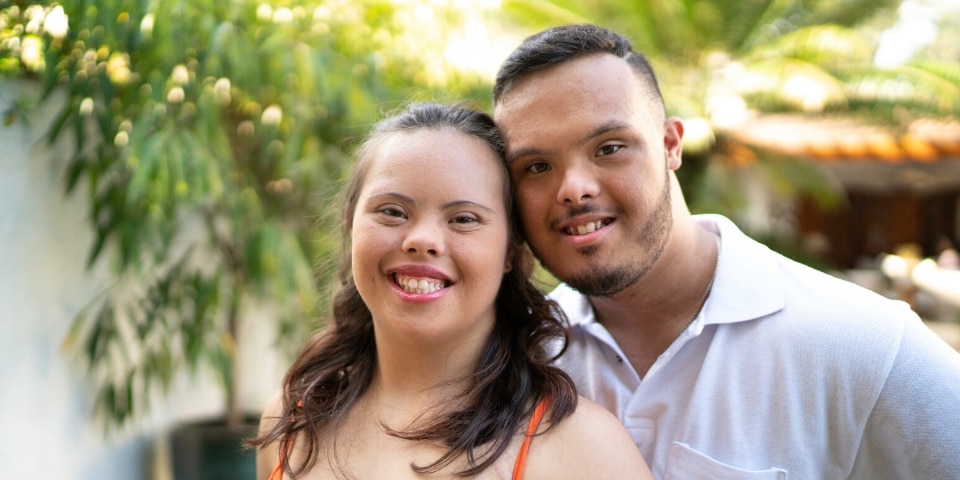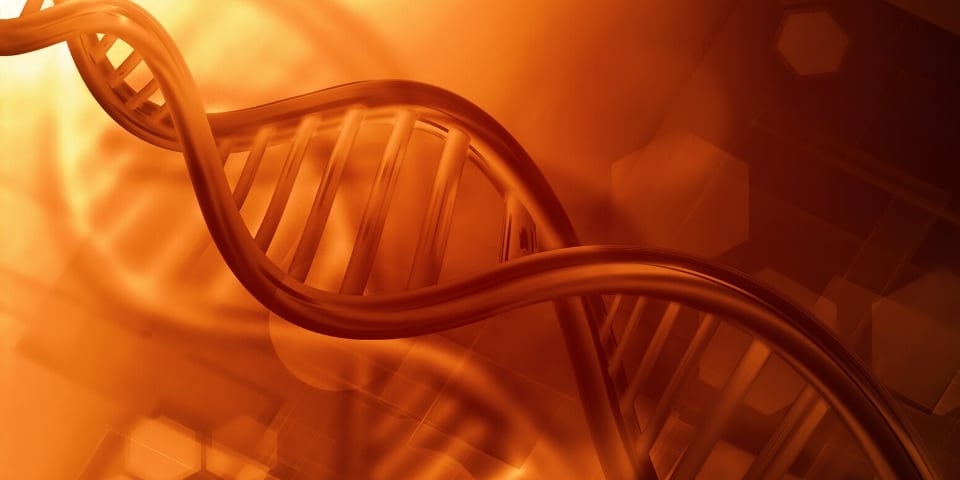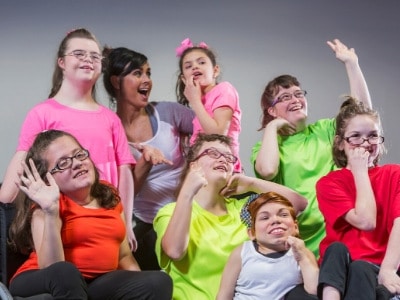چه شرایط دیگر با اختلال طیف اتیسم رخ می دهد ؟
In Australia, 70% of the time a diagnosis of autism is accompanied by an additional condition or diagnosis, and 40% of the time by two or more additional conditions of diagnosis.
این شرایط مشترک می تواند در هر زمان در توسعه فرد ظاهر شود ، و برخی ممکن است تا بعد در نوجوانی و یا حتی بزرگسالی ظاهر می شود.
Several psychiatric, neurodevelopmental, neurological, medical and genetic conditions are also known to co-occur on the autism spectrum at higher rates.
شرایط کلیدی که می تواند علاوه بر تشخیص اوتیسم رخ دهد عبارتند از:

معلولیت ذهنی
Intellectual disability is defined by learning a range of skills at a significantly reduced rate than others in the general population. Signs of developmental delays are evident very early in life.
Intellectual disability varies a lot from child to child and syndrome to syndrome, and ranges from person to person.
برخی از علل کم توانی ذهنی عبارتند از اختلالات ژنتیکی مانند سندرم X شکننده, سندرم داون, سندرم رت.
معلولیت های ذهنی اغلب در دوران کودکی به نسبت اوتیسم تشخیص داده می شوند و معمولا از طریق نشانه های تأخیر تکاملی شناسایی می شوند.
Around 30% of autistic people also have an intellectual disability.
برای کسب اطلاعات بیشتر در مورد کم توانی ذهنی به موسسه بهداشت و رفاه استرالیا.

مهارت های شناختی استثنایی
Exceptional cognitive skills is where a person demonstrates outstanding skills or knowledge which is above the individual’s general level of ability.
Around 29% of people on the autism spectrum have skills that are considered exceptional, including their ability to remember and recall information, to draw using significant recalled visual detail, or to produce music that is pitch perfect.
These skills or knowledge may not necessarily be functional, such as being able to remember train timetables, but not necessarily being able to catch the train.
شرایط سلامت روان
Autistic people with may have mental health conditions such as anxiety, depression, bi-polar, obsessive compulsive disorder, personality disorder, schizophrenia and mood disorders These are separate conditions, and are not part of autism.
تحقیق از دانشگاه Monash ارائه شده در کنفرانس ۲۰۱۹ APAC ، تخمین می زند که در حدود ۶۶ ٪ از افراد مبتلا به تشخیص اوتیسم در حال حاضر همکاری با یک اختلال سلامت روان ، و تا ۸۱ ٪ با یک اختلال سلامت روان در برخی از نقطه زندگی می کنند در طول عمر خود.
در حالی که شرایط سلامت روانی بخشی از اوتیسم نیست ، برخی از ویژگی های اوتیسم ، از جمله مشکلات اجتماعی و رابطه ای ، مشکلات زبان ، و مشکل بیان احساسات می تواند مردم را در طیف اوتیسم به احساس جدا شده منجر شود ، مضطرب و پشتیبانی نشده. این ممکن است به یک فرد در حال توسعه یک وضعیت سلامت روانی کمک.
این مهم است که برای عزیزان, و کسانی که زندگی, کار و یا رفتن به مدرسه با یک فرد در طیف اوتیسم, به خاطر داشته باشید.
افسردگی بالینی
Clinical depression can be common in people across the autism spectrum. The signs of clinical depression include low mood, poor sleep and appetite, irritability or a lack of motivation.
Research clearly shows that clinical depression can impact the quality of life of children, adolescents and adults on the autism spectrum. To find out more, or to learn about ways to manage clinical depression, talk to a qualified health care professional or go to Beyond Blue.
اختلال دوقطبی
اختلال دوقطبی یک بیماری روانی است که می تواند منجر به اوج عاطفی شدید (شیدایی) و پایین ترین شدید (افسردگی).
نشانه هایی از پایین ترین نرخ می تواند شامل داشتن روحیه کم, مشکل خواب, خوردن و یا داشتن یک اشتها ضعیف, یا فاقد انگیزه. نشانه هایی از اوج عاطفی می تواند سطح انرژی بالا و بیش فعالی شامل, و افزایش عزت نفس.
Studies have shown that bipolar disorder is more prevalent in older people on the autism spectrum than in children. To find out more or to learn about ways to manage bipolar disorder talk to a qualified mental health professional or visit the Black Dog Institute.
اختلالات اضطرابی
اختلالات اضطرابی در میان کودکان و نوجوانان در استرالیا شایع است, با گزارش 7% از جوان استرالیایی تشخیص داده شده با نوعی از اختلال اضطراب در هر سال.
همانطور که با بسیاری از چالش های روانی سلامت ، اضطراب ارائه در راه های مختلف، آن را به عنوان در پاسخ فیزیولوژیکی به یک "تهدید واقعی یا درک شده در محیط زیست ، یک پاسخ است که حداکثر توانایی بدن را به صورت یا فرار خطر-' مبارزه یا پرواز '. این می تواند در تعدادی از راه های حاضر: در حال دائما نگران و یا ترس; بودن زمان و در لبه, عصبی و یا ترس; احساس panicky, تحریک پذیر, یا آشفته; یا احساس جسمی بیمار, مانند شما ممکن است استفراغ.
Around 40% of people in Australia on the autism spectrum have an anxiety disorder.
It is particularly important to recognise and treat anxiety in autism as it can exacerbating social withdrawal and make repetitive behaviours which can negatively impact on a persons quality of life. Untreated anxiety in autistic individuals has also been linked to the development of depression.
برای کسب اطلاعات بیشتر در مورد اضطراب و یا به دنبال حمایت از رفتن به سیاه و سفید موسسه سگ.
اختلال وسواسی-اجباری (OCD)
Key signs of obsessive-compulsive disorder (OCD) are having thoughts that you don’t want to have and cannot get rid of, and the need to do specific behaviours to prevent often unrelated negative future events from occurring. People with OCD behave in a “compulsive” way, such as arranging or counting things, or washing their hands over and over again in response to these thoughts and worries.
Research indicates that around 17% of autistic individuals had a co-occurring obsessive-compulsive disorder (OCD) compared to around 2-3% of the general population.
برای کمک و حمایت مربوط به OCD GP خود را ببینید, و یا رفتن به فراتر از آبی برای اطلاعات بیشتر.
شرایط عصبی
Other neurological conditions such as Epilepsy, and Tourette syndrome have been reported as occurring at higher rates among autistic people.
People with Tourette syndrome make involuntary, rapid, repetitive sounds and movements called involuntary tics. Tourette’s is an inherited neurological disorder and can begin between the ages of two and 21 years of age.
Epilepsy is a neurological difference that leads to a person having repeated seizures, which can be visible or not. Current statistics show that 3% of Australians have epilepsy. Around 1% of the general population has epilepsy compared to around 10% of the autistic population.
برو به سلامت مستقیم برای اطلاعات بیشتر و اطلاعات در مورد چگونگی مدیریت سندرم تورت و صرع.
اختلال نقص توجه بیش فعالی (بیش فعالی)
اختلال نقص توجه بیش فعالی (بیش فعالی) رفتار فرد و توسعه را تحت تاثیر قرار. ADHD توسط رفتارها مانند مشخص می شود:
- بی توجهی, و یا مشکل در تمرکز, دستورالعمل های زیر, و یا تکمیل وظایف;
- تکانشگری و
- overactivity ، یا بودن fidgety و بیقرار.
مطالعات نشان داده اند افزایش شیوع هر دو اختلال نقص توجه بیش فعالی (بیش فعالی) و اوتیسم در سال های اخیر, با تحقیقات نشان می دهد که تا دو سوم از افراد مبتلا به ADHD نشان می دهد ویژگی های اوتیسم.
برای کسب اطلاعات بیشتر در مورد ADHD و چگونه بهترین برای مدیریت آن, رفتن به ADHD استرالیا.
مشکلات و معلولیت های یادگیری
حدود ۱۰ تا ۱۶ درصد از مردم با یادگیری مشکل دارند. این می تواند ناشی از: تاخیر تکاملی; هماهنگی ضعیف با توجه به مشکلات مهارت های حرکتی, مسائل عاطفی و صدمات; عدم دسترسی به آموزش مناسب; حضور در مدرسه قطع; یا مسائل مربوط به سلامت.
Some people, around 2 and 4 per cent, have academic skills that are significantly below expectation for their age and intellectual ability.
These are called learning disabilities, and include:
- نارساخوانی: مشکلات مربوط به خواندن ، املا و نوشتن.
- Dyshia: مشکلات بیان از طریق کلمه نوشته شده است ، از جمله املا ، دستخط و ترکیب نوشته شده است.
- Dyscalculia: مشکلات درک اعداد ، ریاضی و تفکر کمی.
- دیسفاژی: مشکلات زبان شفاهی شامل گفتار و درک مطلب.
Studies have shown that there is an increased prevalence of autism among children with a learning disability. This means it’s important for parents and carers to seek advice from teachers and professional support providers about developmental delays specific to learning and academia.
برای کسب اطلاعات بیشتر در مورد مشکلات یادگیری و یا معلولیت به درک مشکلات یادگیری در وزارت امور دولت استرالیا وب سایت آموزش و پرورش.
اختلالات مهارت حرکتی و مشکلات عملکرد بدن
Motor skills are defined as movements and actions of the body’s bone and muscle structure. They are categorised to into gross motor skills and fine motor skills.
مهارت های حرکتی درشت مربوط به حرکت و هماهنگی اندام و دیگر بخش های بزرگ بدن ، و فعالیت های تاثیر مانند در حال اجرا ، خزنده و شنا.
مهارت های حرکتی ظریف مربوط به حرکات کوچکتر در مچ ، دست ها ، انگشتان دست ، پا و انگشتان پا و اقدامات تاثیر مانند چیدن چیزها ، نوشتن با دقت ، و یا حتی چشمک زدن.
Motor skill disorders impact a person’s ability to perform movements requiring fine and/or gross motor skills, and the number of motor difficulties in autistic people has been identified as relatively high.
دیگر عملکردهای مشترک بدن نیز مربوط به اوتیسم, از جمله خواب, دستگاه گوارش و تغذیه مشکلات.
Researchers have found sleep disturbance to be the second most common physical co-condition found in people on the autism spectrum, after epilepsy.
Studies have also found that around 50% of autistic individuals experience some form of gastrointestinal problems.
Feeding problems, including picky eating, chewing and swallowing, in autistic children are also common, with studies showing up to 70% of autistic participants experiencing feeding problems as opposed to 45% in children without autism. There are a range of reasons why an individual may experience difficulties with feeding, including motor issues, fine motor issues, sensory sensitivities, medical and behaviours concerns.
بیقراری جنسیت
بیقراری جنسیت به عنوان "پریشانی یا ناراحتی که ممکن است رخ دهد زمانی که جنس بیولوژیکی فرد و هویت جنسیتی در چین نیست ، تعریف شده است".
Research studies have indicated that people with autism are more likely to experience gender dysphoria, at a rate eleven times greater than the general population. As such, autistic people may need support to understand and accept their gender identity.
برای کسب اطلاعات بیشتر در مورد بیقراری جنسیتی و نحوه مدیریت آن به مستقیم سلامتبروید.



